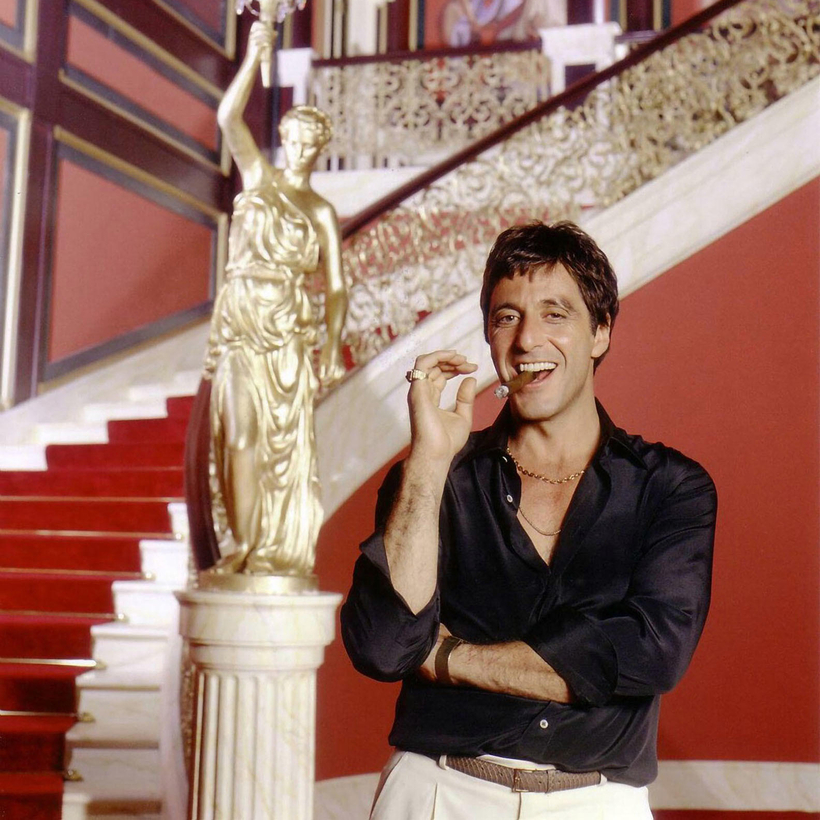How many surprises can there be while researching a 40-year-old movie? Quite a few, as I discovered when I embarked on writing Say Hello to My Little Friend, my new book about Scarface.
The 1932 original, written by Ben Hecht, directed by Howard Hawks, and produced by Howard Hughes, tracks the rise and fall of bootlegger Tony Camonte (Paul Muni). The Scarface remake, written by Oliver Stone and directed by Brian DePalma, re-interprets Hawks’s original into the cocaine era, starring an explosive Al Pacino as Tony Montana, a Cuban-born mobster who climbs to the top of Miami’s cocaine trade. It was released in December 1983 into an eel pit of negative reviews. Critics were incensed by its extreme violence and profanity.
Yet, in the years following its disappointing birth, Scarface gained new life by being embraced by the hip-hop community, an audience the film’s producers didn’t know existed when they made the movie. Rappers Jay-Z, Kool G Rap, Notorious B.I.G. and Tupac Shakur, and other artists have drawn inspiration.

Scarface appealed to this vast underserved audience with its themes of megalomania and wish fulfillment. Pacino’s drug lord, Tony Montana, wants the world. He gets it by choosing to ignore the inevitable downfall that dooms all megalomaniacs. For this reason, Scarface is an abundantly moral film, even though it wallows in exquisite immorality on the way to making its point. Tony loses his sister (Mary Elizabeth Mastrantonio), his wife (Michelle Pfeiffer), and his best friend (Steven Bauer), each of whom suffers for his distorted vision of the American Dream.
And that’s where the surprise comes in, not the smaller one, such as the film’s sly humor, its irony, or its casual wisdom, but the disconnect between the lesson the film teaches, that crime doesn’t pay, and the lesson the audience is supposed to take away, that crime does pay, until it doesn’t.
In the years following its disappointing birth, Scarface gained new life by being embraced by the hip-hop community.
In the old days of the censorious Hollywood Production Code, it was incumbent upon filmmakers to ensure that the villain got his comeuppance in the end. If he didn’t, the film could not be released or had to be re-shot. By the time the letter-rating system was introduced, in 1968, this was the norm. Although the occasional bad guy got away with it (see Steve McQueen in 1968’s The Thomas Crown Affair), in most cases, villains not only died but did so with glorious excess, often thanks to their own devices turned against them.

Scarface was originally given an X rating (NC-17 by today’s system) by the Motion Picture Association for the chainsaws, guns, and 200 f-bombs, plus or minus. After three attempts to recut it to the M.P.A.’s vague specifications, De Palma reinstated all the deleted footage, figuring that if he was going to get an X rating, he might as well go down in flames.
At this point, producer Martin Bregman stepped in, demanding an appeal before the ratings board. Calling on psychiatrists and educators, he made the case that although Scarface contained violence and profanity, Montana’s fate served as a warning to young viewers and, therefore, the X rating should be reduced to an R.
The ratings board bought it. Scarface won its R.
And yet the audience didn’t care about Tony’s fall. They loved his unhinged mayhem, applauded his violence, and cheered on his killings, and they still do 40 years later. Since 1983, the sins flaunted so operatically by Tony and his cabal of drug lords have been ignored. The lessons audiences take away from Scarface are not the end, which is explosive, but in the journey, which is flamboyant.
The now cult status of Scarface symbolizes the yearnings of a culture that has been ignored and suppressed, an audience whose only way out of its situation was (however accurately) by breaking the law. Success is financial, early death is presumed, and the candle is set aflame not only at both ends, but in the middle.
The surprise of Scarface is that it achieved success not only because of its filmmaking craft but because of the message it contains, and that message is profoundly misunderstood, if not ignored. Crime does pay. Especially at the box office.

Nat Segaloff’s Say Hello to My Little Friend: A Century of Scarface is out now from Kensington/Citadel


